Review on Energy and Fire Performance of Water Wall Systems as a Green Building Façade
Abstract
1. Introduction
2. Materials and Methods
3. Water Wall Systems
3.1. Evolution of Water Wall Systems
3.2. Classification of Water Wall Systems
3.2.1. Opaque Water Wall
3.2.2. Semi-Transparent Water Wall
3.2.3. Water Wall with Phase Change Materials (PCMs)
3.3. Components of a Semitransparent WWS
3.3.1. Glazing
3.3.2. Water Layer
4. Energy Performance of Water Wall Systems
4.1. Past Research on Assessing Thermal Performance of WWS
4.1.1. Experimental Modeling of Thermal Performance of WWS
4.1.2. Analytical Modeling of Thermal Performance of WWS
4.1.3. CFD Modeling of Thermal Performance of WWS
5. Fire Performance of Water Wall Systems
6. Water Walls as a Green Building Façade
6.1. Economic Cost of WWS
6.2. Embodied Energy of WWS
6.3. Energy Consumption and Greenhouse Gas Emissions
6.4. Recyclability
6.5. Human Friendliness
7. Shortcomings of Past WWS Research and Future Directions
8. Conclusions
Author Contributions
Funding
Conflicts of Interest
References
- Pérez, G.; Coma, J.; Sol, S.; Cabeza, L.F. Green facade for energy savings in buildings: The influence of leaf area index and facade orientation on the shadow effect. Appl. Energy 2017, 187, 424–437. [Google Scholar] [CrossRef]
- Tzempelikos, A.; Athienitis, A.K.; Karava, P. Simulation of façade and envelope design options for a new institutional building. Sol. Energy 2007, 81, 1088–1103. [Google Scholar] [CrossRef]
- Chen, J.; Qiu, Q.; Han, Y.; Lau, D. Piezoelectric materials for sustainable building structures: Fundamentals and applications. Renew. Sustain. Energy Rev. 2019, 101, 14–25. [Google Scholar] [CrossRef]
- Chew, M.Y.L.; Conejos, S.; Azril, F.H. Bin Design for maintainability of high-rise vertical green facades. Build. Res. Inf. 2019, 47, 453–467. [Google Scholar] [CrossRef]
- Aksamija, A. High-Performance Building Envelopes: Design Methods for Energy Efficient Facades. In Proceedings of the BEST4 Conference, Kansas City, MO, USA, 13–15 April 2015. [Google Scholar]
- Haggag, M.; Hassan, A.; Elmasry, S. Experimental study on reduced heat gain through green façades in a high heat load climate. Energy Build. 2014, 82, 668–674. [Google Scholar] [CrossRef]
- Khanna, T.; Chhugani, R. Intelligent Facades to Improve Sustainability & Comfort; NürnbergMesse India Pvt. Ltd.: New Delhi, India, 2016. [Google Scholar]
- Wang, Y.; Fukuda, H. The influence of insulation styles on the building energy consumption and indoor thermal comfort of multi-family residences. Sustainability 2019, 11, 266. [Google Scholar] [CrossRef]
- Rakhshandehroo, M.; Yusof, M.J.M.; Najd, M.D. Green Façade (Vertical Greening): Benefits and Threats. Appl. Mech. Mater. 2015, 747, 12–15. [Google Scholar] [CrossRef]
- Carletti, C.; Sciurpi, F.; Pierangioli, L. The energy upgrading of existing buildings: Window and shading device typologies for energy efficiency refurbishment. Sustainability 2014, 6, 5354–5377. [Google Scholar] [CrossRef]
- Khasreen, M.M.; Banfill, P.F.G.; Menzies, G.F. Life-cycle assessment and the environmental impact of buildings: A review. Sustainability 2009, 1, 674–701. [Google Scholar] [CrossRef]
- Joseph, P.; Tretsiakova-McNally, S. Sustainable non-metallic building materials. Sustainability 2010, 2, 400–427. [Google Scholar] [CrossRef]
- Guo, P.; Meng, W.; Nassif, H.; Gou, H.; Bao, Y. New perspectives on recycling waste glass in manufacturing concrete for sustainable civil infrastructure. Constr. Build. Mater. 2020, 257. [Google Scholar] [CrossRef]
- Bahadori-Jahromi, A.; Rotimi, A.; Mylona, A.; Godfrey, P.; Cook, D. Impact of window films on the overall energy consumption of existing UK hotel buildings. Sustainability 2017, 9, 731. [Google Scholar] [CrossRef]
- Zhou, A.; Wong, K.W.; Lau, D. Thermal insulating concrete wall panel design for sustainable built environment. Sci. World J. 2014, 2014. [Google Scholar] [CrossRef] [PubMed]
- Zhou, A.; Yu, Z.; Chow, C.L.; Lau, D. Enhanced solar spectral reflectance of thermal coatings through inorganic additives. Energy Build. 2017, 138, 641–647. [Google Scholar] [CrossRef]
- Morakinyo, T.E.; Dahanayake, K.W.D.K.C.; Ng, E.; Chow, C.L. Temperature and cooling demand reduction by green-roof types in different climates and urban densities: A co-simulation parametric study. Energy Build. 2017, 145, 226–237. [Google Scholar] [CrossRef]
- Wang, F.; Yang, W.J.; Sun, W.F. Heat transfer and energy consumption of passive house in a severely cold area: Simulation analyses. Energies 2020, 13, 626. [Google Scholar] [CrossRef]
- Dahanayake, K.W.D.K.C.; Chow, C.L. Studying the potential of energy saving through vertical greenery systems: Using EnergyPlus simulation program. Energy Build. 2017, 138, 47–59. [Google Scholar] [CrossRef]
- Chow, W.K.; Kong, H.; Gao, Y.; Dong, H.; Zou, G.W.; Han, S.S.; Kong, H.; Chow, C.L.; Kong, H. Experimental studies on fire response of glass façade systems. IJEPBFC 2006, 8, 54–68. [Google Scholar]
- Khalaf, M.; Ashrafian, T.; Demirci, C. Energy Efficiency Evaluation of Different Glazing and Shading Systems in a School Building. E3S Web Conf. 2019, 111. [Google Scholar] [CrossRef]
- Huang, Y.; Niu, J.L. Energy and visual performance of the silica aerogel glazing system in commercial buildings of Hong Kong. Constr. Build. Mater. 2015, 94, 57–72. [Google Scholar] [CrossRef]
- Wang, Y.; Wu, Y.; Wang, Q.; Liew, K.M.; Chen, H.; Sun, J.; He, L. Numerical study on fire response of glass facades in different installation forms. Constr. Build. Mater. 2014, 61, 172–180. [Google Scholar] [CrossRef]
- Stewart, M.G.; Netherton, M.D. Security risks and probabilistic risk assessment of glazing subject to explosive blast loading. Reliab. Eng. Syst. Saf. 2008, 93, 627–638. [Google Scholar] [CrossRef]
- Vedrtnam, A.; Bedon, C.; Youssef, M.A.; Wamiq, M.; Sabsabi, A.; Chaturvedi, S. Experimental and numerical structural assessment of transparent and tinted glass during fire exposure. Constr. Build. Mater. 2020, 250. [Google Scholar] [CrossRef]
- Bedon, C.; Zhang, X.; Santos, F.; Honfi, D.; Kozłowski, M.; Arrigoni, M.; Figuli, L.; Lange, D. Performance of structural glass facades under extreme loads—Design methods, existing research, current issues and trends. Constr. Build. Mater. 2018, 163, 921–937. [Google Scholar] [CrossRef]
- Debuyser, M.; Sjöström, J.; Lange, D.; Honfi, D.; Sonck, D.; Belis, J. Behaviour of monolithic and laminated glass exposed to radiant heating. Constr. Build. Mater. 2017, 130, 212–229. [Google Scholar] [CrossRef]
- Wang, Y.; Xie, Q.; Zhang, Y.; Wang, Q.; Sun, J. Sensitivity analysis of influencing factors on glass façade breakage in fire. Fire Saf. J. 2018, 98, 38–47. [Google Scholar] [CrossRef]
- Cuzzillo, B.R.; Pagni, P.J. Thermal breakage of Double-Pane Glazing by Fire. J. Fire Prot. Eng. 1998, 9, 1–11. [Google Scholar] [CrossRef]
- Wang, Y.; Wang, Q.; Sun, J.; He, L.; Liew, K.M. Influence of fire location on the thermal performance of glass façades. Appl. Therm. Eng. 2016, 106, 438–442. [Google Scholar] [CrossRef]
- Pagni, P.J. Thermal glass breakage. Fire Saf. Sci. 2003, 3–22. [Google Scholar] [CrossRef]
- Cho, S.H.; Chae, C.U. A study on life cycle CO2 emissions of low-carbon building in South Korea. Sustainability 2016, 8, 579. [Google Scholar] [CrossRef]
- Tidwell, J. Bridging the Gap—Fire Safety and Green Buildings; National Association of State Fire Marshals: Burns, OR, USA, 2010. [Google Scholar]
- Nayak, J.K. Thermal performance of a water wall. Build. Environ. 1987, 22, 83–90. [Google Scholar] [CrossRef]
- Wu, T.; Lei, C. A review of research and development on water wall for building applications. Energy Build. 2016, 112, 198–208. [Google Scholar] [CrossRef]
- Wu, T.; Lei, C. Thermal modelling and experimental validation of a semi-transparent water wall system for Sydney climate. Sol. Energy 2016, 136, 533–546. [Google Scholar] [CrossRef]
- Wu, T.; Lei, C. CFD simulation of the thermal performance of an opaque water wall system for Australian climate. Sol. Energy 2016, 133, 141–154. [Google Scholar] [CrossRef]
- Wang, H.; Lei, C. Theoretical modeling of combined solar chimney and water wall for buildings. Energy Build. 2019, 187, 186–200. [Google Scholar] [CrossRef]
- Wang, H.; Lei, C. Combined Solar Chimney and Water Wall for Ventilation and Thermal Comfort. In Proceedings of the 4th International Conference on Building Energy, Environment, Melbourne, Australia, 5–9 February 2018; pp. 705–710. [Google Scholar]
- Karabay, H.; Arici, M.; Sandik, M. A numerical investigation of fluid flow and heat transfer inside a room for floor heating and wall heating systems. Energy Build. 2013, 67, 471–478. [Google Scholar] [CrossRef]
- Moustafa, M.A.; Aripin, S. CFD Evaluation of the pottery water wall in a hot adrid climate of Luxor, Egypt. J. Green Build. 2015. [Google Scholar] [CrossRef]
- Xiangfeng, L.; Tianxing, S. Conceptual Development of Transparent Water Storage Envelopes. Archit. Sci. Rev. 2007, 50, 18–25. [Google Scholar] [CrossRef]
- Liu, X.; Guo, J.; Wang, J. Numerical and experimental studies on the energy performance of thermal mass windows. J. Build. Phys. 2018, 42, 692–721. [Google Scholar] [CrossRef]
- Wang, X.; Kim, R.E.; Kwon, O.S.; Yeo, I. Hybrid Simulation Method for a Structure Subjected to Fire and Its Application to a Steel Frame. J. Struct. Eng. 2018, 144, 1–11. [Google Scholar] [CrossRef]
- Kuznik, F.; David, D.; Johannes, K.; Roux, J.J. A review on phase change materials integrated in building walls. Renew. Sustain. Energy Rev. 2011, 15, 379–391. [Google Scholar] [CrossRef]
- Tamme, R.; Laing, D.; Steinmann, W.D.; Bauer, T. Thermal Energy Storage. Sol. Energy 2013, 688–714. [Google Scholar] [CrossRef]
- Perlin, J. Let It Shine: The 6,000-Year Story of Solar Energy; New World Library: Novato, CA, USA, 2013; ISBN 9781608681327. [Google Scholar]
- Bainbridge, D.A. A Water Wall Solar Design Manual; San Diego, CA, USA, 2005; Available online: https://www.solaripedia.com/files/472.pdf (accessed on 13 October 2020).
- Maloney, T.J.; Habib, V. Design, Fabrication and Testing of a Marketable Waterwall Component; One Design, Inc.: Winchester, VA, USA, 1979; Volume 84. [Google Scholar]
- Bainbridge, B.D.A.; Haggard, K.; Cooper, P. Return of the Water Wall. Sol. Today 2007, 38–41. [Google Scholar]
- Saadatian, O.; Sopian, K.; Lim, C.H.; Asim, N.; Sulaiman, M.Y. Trombe walls: A review of opportunities and challenges in research and development. Renew. Sustain. Energy Rev. 2012, 16, 6340–6351. [Google Scholar] [CrossRef]
- Saadatian, O.; Sopian, K.; Salleh, E.; Lim, C.H.; Riffat, S.; Saadatian, E.; Toudeshki, A.; Sulaiman, M.Y. A review of energy aspects of green roofs. Renew. Sustain. Energy Rev. 2013, 23, 155–168. [Google Scholar] [CrossRef]
- Bevilacqua, P.; Benevento, F.; Bruno, R.; Arcuri, N. Are Trombe walls suitable passive systems for the reduction of the yearly building energy requirements? Energy 2019, 185, 554–566. [Google Scholar] [CrossRef]
- Agrawal, B.; Tiwari, G.N. Building Integrated Photovoltaic Thermal Systems: For Sustainable Development; Royal Society of Chemistry: London, UK, 2011; ISBN 9781849732000. [Google Scholar]
- Al-Karaghouli, A.; Kazmerski, L.L. Renewable Energy Opportunities in Water Desalination. Desalin. Trends Technol. 2011. [Google Scholar] [CrossRef]
- McLaggan, M.S.; Hadden, R.M.; Gillie, M. Fire Performance of Phase Change Material Enhanced Plasterboard. Fire Technol. 2018, 54, 117–134. [Google Scholar] [CrossRef]
- Khan, R.J.; Bhuiyan, M.Z.H.; Ahmed, D.H. Investigation of heat transfer of a building wall in the presence of phase change material (PCM). Energy Built Environ. 2020, 1, 199–206. [Google Scholar] [CrossRef]
- Richman, R.C.; Cianfrone, C.; Pressnail, K.D. More sustainable masonry façades: Preheating ventilation air using a dynamic buffer zone. J. Build. Phys. 2010, 34, 27–41. [Google Scholar] [CrossRef]
- Stazi, F.; Mastrucci, A.; Munafò, P. Life cycle assessment approach for the optimization of sustainable building envelopes: An application on solar wall systems. Build. Environ. 2012, 58, 278–288. [Google Scholar] [CrossRef]
- Kisilewicz, T. On the role of external walls in the reduction of energy demand and the mitigation of human thermal discomfort. Sustainability 2019, 11, 61. [Google Scholar] [CrossRef]
- Yang, L.; Yan, H.; Lam, J.C. Thermal comfort and building energy consumption implications -A review. Appl. Energy 2014, 115, 164–173. [Google Scholar] [CrossRef]
- Li, D.; Wu, Y.; Wang, B.; Liu, C.; Arıcı, M. Optical and thermal performance of glazing units containing PCM in buildings: A review. Constr. Build. Mater. 2020, 233, 117327. [Google Scholar] [CrossRef]
- Balcomb, J.D.; Mcfarland, R.D. A simple empirical method for estimating the performance of a passive solar heated building of the thermal storage wall type. In Proceedings of the 2nd National Passive Solar, University of Pennsylvania, Philadelphia, PA, USA, 16–18 March 1978. [Google Scholar]
- Nayak, J.K.; Bansal, N.K.; Sodha, M.S. Analysis of passive heating concepts. Sol. Energy 1983, 30, 51–69. [Google Scholar] [CrossRef]
- Sutton, R.G.; McGregor, R.J. Solarwall project: Two demonstration houses with passive solar heating in Tasmania. Archit. Sci. Rev. 1986, 29, 2–11. [Google Scholar] [CrossRef]
- Turner, R.H.; Liu, G.; Cengel, Y.A.; Harris, C.P. Thermal Storage in the Walls of a Solar House. J. Sol. Eng. 1994, 116, 183–193. [Google Scholar] [CrossRef]
- Yadav, Y.P.; Tiwari, G.N. Analytical model of a solarium for cold climate-A new approach. Energy Convers. Manag. 1988, 28, 15–20. [Google Scholar] [CrossRef]
- Din, M.; Tiwari, G.N.; Ghosal, M.K.; Srivastava, N.S.L.; Khan, M.I.; Sodha, M.S. Effect of thermal storage on the performance of greenhouse. Int. J. Energy Res. 2003, 27, 79–92. [Google Scholar] [CrossRef]
- Tiwari, G.N.; Singh, A.K. Comparative Studies of Different Heating Techniques of a Non-air Conditioned Building. Build. Environ. 1996, 31, 215–224. [Google Scholar] [CrossRef]
- Fuchs, R.; McClelland, J.F. Passive solar heating of buildings using a transwall structure. Sol. Energy 1979, 23, 123–128. [Google Scholar] [CrossRef]
- Bansal, N.K.; Sodha, M.S.; Ram, S.; Singh, S.P. Evaluation of complex heat transfer coefficients for passive heating concepts. Build. Environ. 1987, 22, 259–268. [Google Scholar] [CrossRef]
- Bansal, N.K.; Thomas, P.C. A Simple Procedure for Selection and Sizing of Indirect Passive Solar Heating Systems. Build. Environ. 1991, 26, 381–387. [Google Scholar] [CrossRef]
- Bhandari, M.S.; Bansal, N.K. Solar heat gain factors and heat loss coefficients for passive heating concepts. Sol. Energy 1994, 53, 199–208. [Google Scholar] [CrossRef]
- Nisbet, S.K.; Mthembu, N.S. Transwall modelling using effective conductivities. Sol. Energy 1992, 49, 127–138. [Google Scholar] [CrossRef]
- Yadav, Y.P.; Tiwari, G.N. Large scale solar water heater: Experimental and theoretical studies. Energy Convers. Manag. 1991, 31, 337–351. [Google Scholar] [CrossRef]
- Tiwari, G.N.; Kumar, S. Thermal evaluation of solarium-cum-passive solar house. Energy Convers. Manag. 1991, 32, 303–310. [Google Scholar] [CrossRef]
- Upadhya, M.; Tiwari, G.N.; Rai, S.N. Optimum distribution of water-wall thickness in a transwall. Energy Build. 1991, 17, 97–102. [Google Scholar] [CrossRef]
- Wang, W.L.; Tian, Z.; Niu, X.L.; Xu, X. Investigation on a Passive Solar House Equipped with Water Thermal Storage Wall. Appl. Mech. Mater. 2012, 178–181, 193–196. [Google Scholar] [CrossRef]
- Sánchez-Ostiz, A.; Monge-Barrio, A.; Domingo-Irigoyen, S.; González-Martínez, P. Design and experimental study of an industrialized sunspace with solar heat storage. Energy Build. 2014, 80, 231–246. [Google Scholar] [CrossRef]
- Sameti, M. A new design of a solar water storage wall: A system-level model and simulation. Energy Syst. 2018, 9, 361–383. [Google Scholar] [CrossRef]
- Chow, T.T.; Li, C.; Lin, Z. Thermal characteristics of water-flow double-pane window. Int. J. Therm. Sci. 2011, 50, 140–148. [Google Scholar] [CrossRef]
- Sodha, M.S.; Kaushik, S.C.; Nayak, J.K. Performance of trombe walls and roof pond systems. Appl. Energy 1981, 8, 175–191. [Google Scholar] [CrossRef]
- Yadav, Y.P.; Tiwari, G.N. Transient analysis of a winter greenhouse integrated with solar still. Energy Convers. Manag. 1987, 27, 267–273. [Google Scholar] [CrossRef]
- Tiwari, G.N.; Yadav, Y.P.; Lawrence, S.A. Performance of a solarium: An analytical study. Build. Environ. 1988, 23, 145–151. [Google Scholar] [CrossRef]
- Xiangfeng, L.; Tianxing, S. The Development of Transparent Water Storage Envelopes (TWSE) through Theoretical Thermal and Optical Analyses. Archit. Sci. Rev. 2008, 51, 109–123. [Google Scholar] [CrossRef]
- Chow, T.T.; Li, C. Water-filled double reflective window and its year-round performance. Procedia Environ. Sci. 2011, 11, 1039–1047. [Google Scholar] [CrossRef]
- Lyu, Y.L.; Chow, T.T.; Wang, J.L. Numerical prediction of thermal performance of liquid-flow window in different climates with anti-freeze. Energy 2018, 157, 412–423. [Google Scholar] [CrossRef]
- Gil-Lopez, T.; Gimenez-Molina, C. Influence of double glazing with a circulating water chamber on the thermal energy savings in buildings. Energy Build. 2013, 56, 56–65. [Google Scholar] [CrossRef]
- Lyu, Y.L.; Chow, T.T. Evaluation of influence of header design on water flow characteristics in window cavity with CFD. Energy Procedia 2015, 78, 97–102. [Google Scholar] [CrossRef]
- Chow, T.T.; Lyu, Y. Effect of design configurations on water flow window performance. Sol. Energy 2017, 155, 354–362. [Google Scholar] [CrossRef]
- Liu, X.; Xu, M.; Guo, J.; Zhu, R. Numerical study on the energy performance of building zones with transparent water storage envelopes. Sol. Energy 2019, 180, 690–706. [Google Scholar] [CrossRef]
- Gutai, M.; Kheybari, A.G. Energy consumption of water-filled glass (WFG) hybrid building envelope. Energy Build. 2020, 218, 110050. [Google Scholar] [CrossRef]
- Sȩdłak, B.; Kinowski, J.; Sulik, P.; Kimbar, G. The risks associated with falling parts of glazed facades in case of fire. Open Eng. 2018, 8, 147–155. [Google Scholar] [CrossRef]
- Hasheminasab, H.; Zolfani, S.H.; Bitarafan, M.; Chatterjee, P.; Ezabadi, A.A. The Role of Façade Materials in Blast-Resistant Buildings: An Evaluation Based on Fuzzy Delphi and Fuzzy EDAS. Algorithms 2019, 12, 119. [Google Scholar] [CrossRef]
- Nguyen, K.; Weerasinghe, P.; Mendis, P.; Ngo, T.; Barnett, J. Performance of modern building facades in fire: A comprehensive review. Electron. J. Struct. Eng. 2016, 16, 69–86. [Google Scholar]
- McKenna, S.T.; Jones, N.; Peck, G.; Dickens, K.; Pawelec, W.; Oradei, S.; Harris, S.; Stec, A.A.; Hull, T.R. Fire behaviour of modern façade materials – Understanding the Grenfell Tower fire. J. Hazard. Mater. 2019, 368, 115–123. [Google Scholar] [CrossRef]
- Wang, Y.; Zhang, Y.; Wang, Q.; Yang, Y.; Sun, J. The effect of glass panel dimension on the fire response of glass façades. Constr. Build. Mater. 2018, 181, 588–597. [Google Scholar] [CrossRef]
- Chow, W.K.; Hung, W.Y.; Gao, Y.; Zou, G.; Dong, H. Experimental study on smoke movement leading to glass damages in double-skinned façade. Constr. Build. Mater. 2007, 21, 556–566. [Google Scholar] [CrossRef]
- Quinn, M.; Nadjai, A.; Ali, F.; Abu-Tair, A. Experimental and numerical investigation of localised fire on glazing facades having different orientations. J. Struct. Fire Eng. 2013, 4, 153–164. [Google Scholar] [CrossRef]
- Babrauskas, V. Glass breakage in fires. Fire Sci. Technol. Inc. 2011, 6–11. Available online: http://doctorfire.com/GlassBreak.pdf (accessed on 13 October 2020).
- Keski-Rahkonen, O. Breaking of window glass close to fire. Fire Mater. 1988, 12, 61–69. [Google Scholar] [CrossRef]
- Pagni, P.J.; Joshi, A.A. Glass breaking in fires. Fire Saf. Sci. Proc. Third Int. Symp. 2006, 791–802. [Google Scholar] [CrossRef]
- Mowrer, F. Window Breakage Induced by Exterior Fires; National Institute of Standards and Technology: Gaithersburg, MD, USA, 1997. [Google Scholar]
- Chow, C.L. Numerical studies on smoke spread in the cavity of a double-skin façade. J. Civ. Eng. Manag. 2016, 22, 470–479. [Google Scholar] [CrossRef]
- Manzello, S.L.; Gann, R.G.; Kukuck, S.R.; Prasad, K.R.; Jones, W.W. An experimental determination of a real fire performance of a non-load bearing glass wall assembly. Fire Technol. 2007, 43, 77–89. [Google Scholar] [CrossRef]
- Wang, X.; Tan, Q.; Wang, Z.; Kong, X.; Cong, H. Preliminary study on fire protection of window glass by water mist curtain. Int. J. Therm. Sci. 2018, 125, 44–51. [Google Scholar] [CrossRef]
- Turco, M.; Lhotsky, P.; Hadjisophocleous, G. Investigation into the use of a water curtain over openings to prevent fire spread. MATEC Web Conf. 2016, 46. [Google Scholar] [CrossRef]
- Tseng, C.C.; Viskanta, R. Absorptance and transmittance of water spray/mist curtains. Fire Saf. J. 2007, 42, 106–114. [Google Scholar] [CrossRef]
- Abdoh, D.A.; Ademiloye, A.S.; Liew, K.M. A meshfree analysis of the thermal behaviors of hot surface glass pane subjects to down-flowing water film via smoothed particle hydrodynamics. Eng. Anal. Bound. Elem. 2020, 120, 195–210. [Google Scholar] [CrossRef]
- Shao, G.; Wang, Q.; Zhao, H.; Wang, Y.; Chen, H.; Su, Y.; Sun, J.; He, L. Maximum temperature to withstand water film for tempered glass exposed to fire. Constr. Build. Mater. 2014, 57, 15–23. [Google Scholar] [CrossRef]
- Braun, J.E. Load control using building thermal mass. J. Sol. Energy Eng. Trans. ASME 2003, 125, 292–301. [Google Scholar] [CrossRef]
- Shi, Y.; Liu, X. Research on the Literature of Green Building Based on the Web of Science: A Scientometric Analysis in Citespace (2002–2018). Sustainability 2019, 11, 3716. [Google Scholar] [CrossRef]
- Cakmakli, A.B. Environmental Analysis of Construction Materials. In Green Building Management and Smart Automation; Solanki, A., Nayyar, A., Eds.; IGI Global: Pennsylvania, PA, USA, 2019; pp. 90–110. [Google Scholar] [CrossRef]
- Akadiri, P.O.; Chinyio, E.A.; Olomolaiye, P.O. Design of A Sustainable Building: A Conceptual Framework for Implementing Sustainability in the Building Sector. Buildings 2012, 2, 126–152. [Google Scholar] [CrossRef]
- Biswas, W.K. Carbon footprint and embodied energy consumption assessment of building construction works in Western Australia. Int. J. Sustain. Built Environ. 2014, 3, 179–186. [Google Scholar] [CrossRef]
- Baird, G.; Alcorn, A.; Haslam, P. The Energy Embodied in Building Materials—Updated New Zealand Coefficients and Their Significance. Trans. Inst. Prof. Eng. New Zeal. Civ. Eng. Sect. 1997, 24, 46–54. [Google Scholar]
- Lawson, B. Building Materials, Energy and the Environment: Towards Ecologically Sustainable Development; Royal Australian Institute of Architects: Victoria, Australia, 1996; ISBN 9781863180283. [Google Scholar]
- Straube, J. Can Highly Glazed Building Façades Be Green. Available online: https://www.buildingscience.com/documents/insights/bsi-006-can-fully-glazed-curtainwalls-be-green (accessed on 19 October 2020).
- Bunjongjit, S.; Ngaopitakkul, A. Feasibility study and impact of daylight on illumination control for Energy-saving lighting systems. Sustainability 2018, 10, 4075. [Google Scholar] [CrossRef]
- Kaminska, A.; Ozadowicz, A. Lighting control including daylight and energy efficiency improvements analysis. Energies 2018, 11, 2166. [Google Scholar] [CrossRef]
- Al-Mansour, A.; Chow, C.L.; Feo, L.; Penna, R.; Lau, D. Green concrete: By-products utilization and advanced approaches. Sustainability 2019, 11, 5145. [Google Scholar] [CrossRef]
- Albayyaa, H.; Hagare, D.; Saha, S. Energy conservation in residential buildings by incorporating Passive Solar and Energy Efficiency Design Strategies and higher thermal mass. Energy Build. 2019, 182, 205–213. [Google Scholar] [CrossRef]
- Aboulnaga, M.M. Towards green buildings: Glass as a building element—The use and misuse in the gulf region. Renew. Energy 2006, 31, 631–653. [Google Scholar] [CrossRef]
- Altan, H.; Hajibandeh, M.; Aoul, T.K.A.; Deep, A. Passive design. In Springer Tracts in Civil Engineering; Springer: Cham, Switzerland, 2016; pp. 209–236. [Google Scholar] [CrossRef]
- Burkett, K. The Hidden Architecture Behind 7 Deceiving Façades. Architizer, 2019. Available online: https://architizer.com/blog/inspiration/collections/deceiving-facades (accessed on 13 October 2020).
- Nijsse, R.; Wenting, R. Designing and constructing corrugated glass facades. J. Facade Des. Eng. 2014, 2, 123–131. [Google Scholar] [CrossRef]
- Allen, E. How Buildings Work; Oxford UniversityPress: New York, NY, USA, 2005; Volume 53, ISBN 9788578110796. [Google Scholar]
- Maller, C.; Townsend, M.; Pryor, A.; Brown, P.; St Leger, L. Healthy nature healthy people: “contact with nature” as an upstream health promotion intervention for populations. Health Promot. Int. 2006, 21, 45–54. [Google Scholar] [CrossRef] [PubMed]
- De Been, I.; Beijer, M. The influence of office type on satisfaction and perceived productivity support. J. Facil. Manag. 2014, 12, 142–157. [Google Scholar] [CrossRef]
- Adams, S.; Becker, M.; Krauss, D.; Gilman, C. Not a Dry Subject: Optimizing Water Trombe Walls. Sol. Energy Soc. Annu. Conf. 2010, 2010, 1334–1340. [Google Scholar]
- Tiwari, G.N.; Upadhya, M.; Rai, S.N. Relative thermal performances of south walls in winter. Energy Build. 1991, 17, 313–320. [Google Scholar] [CrossRef]
- Crawley, D.B.; Hand, J.W.; Kummert, M.; Griffith, B.T. Contrasting the capabilities of building energy performance simulation programs. Build. Environ. 2008, 43, 661–673. [Google Scholar] [CrossRef]
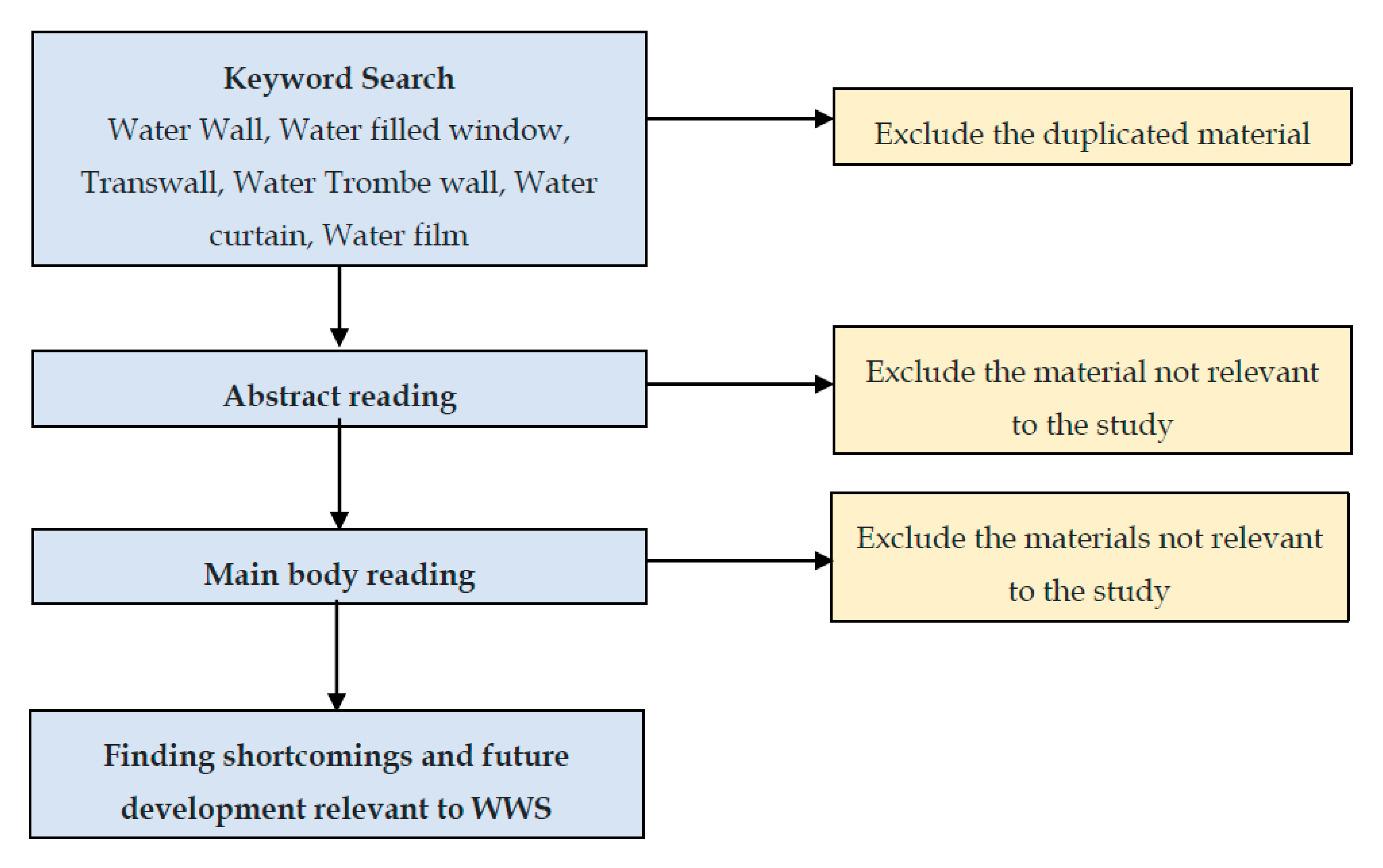
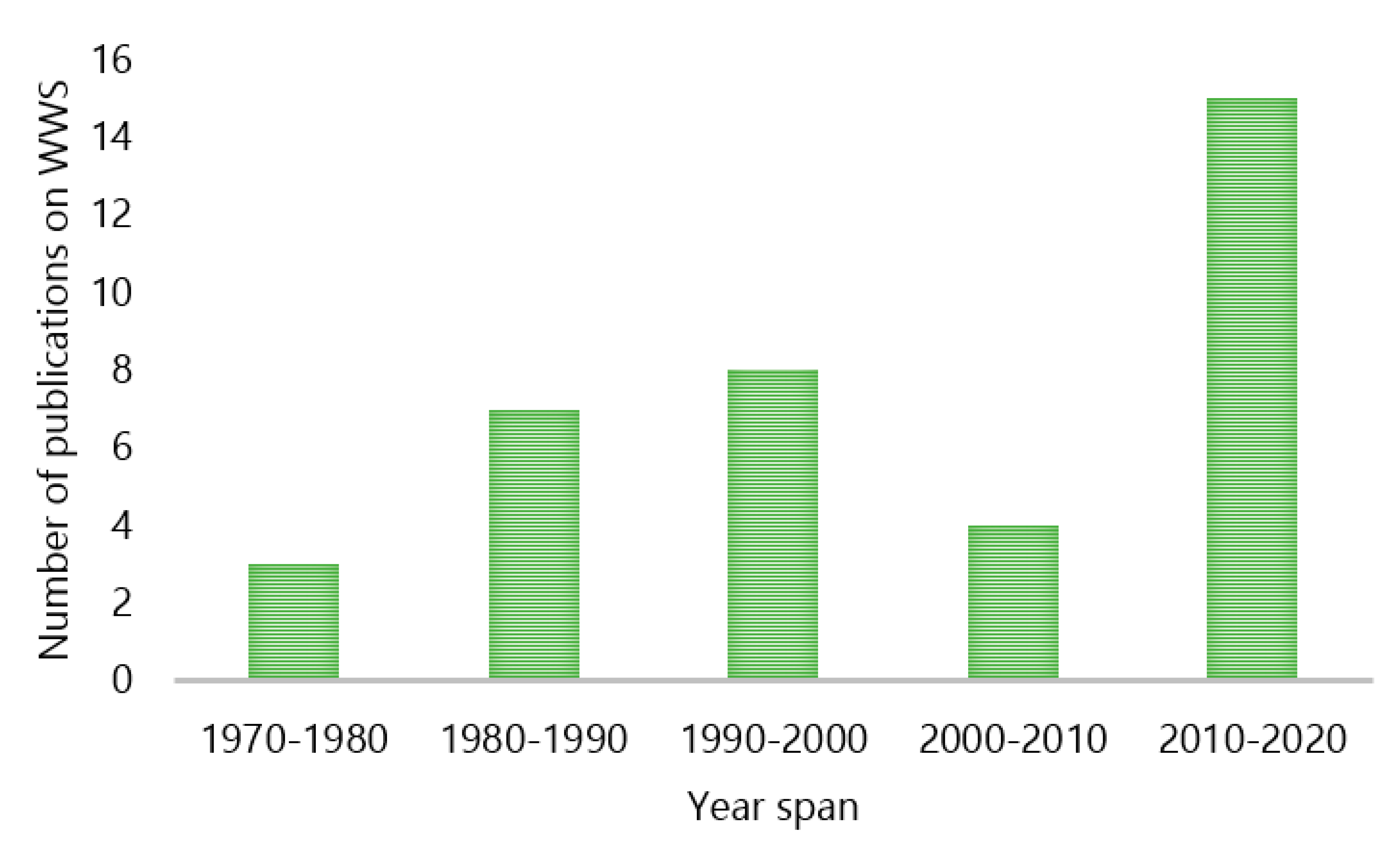


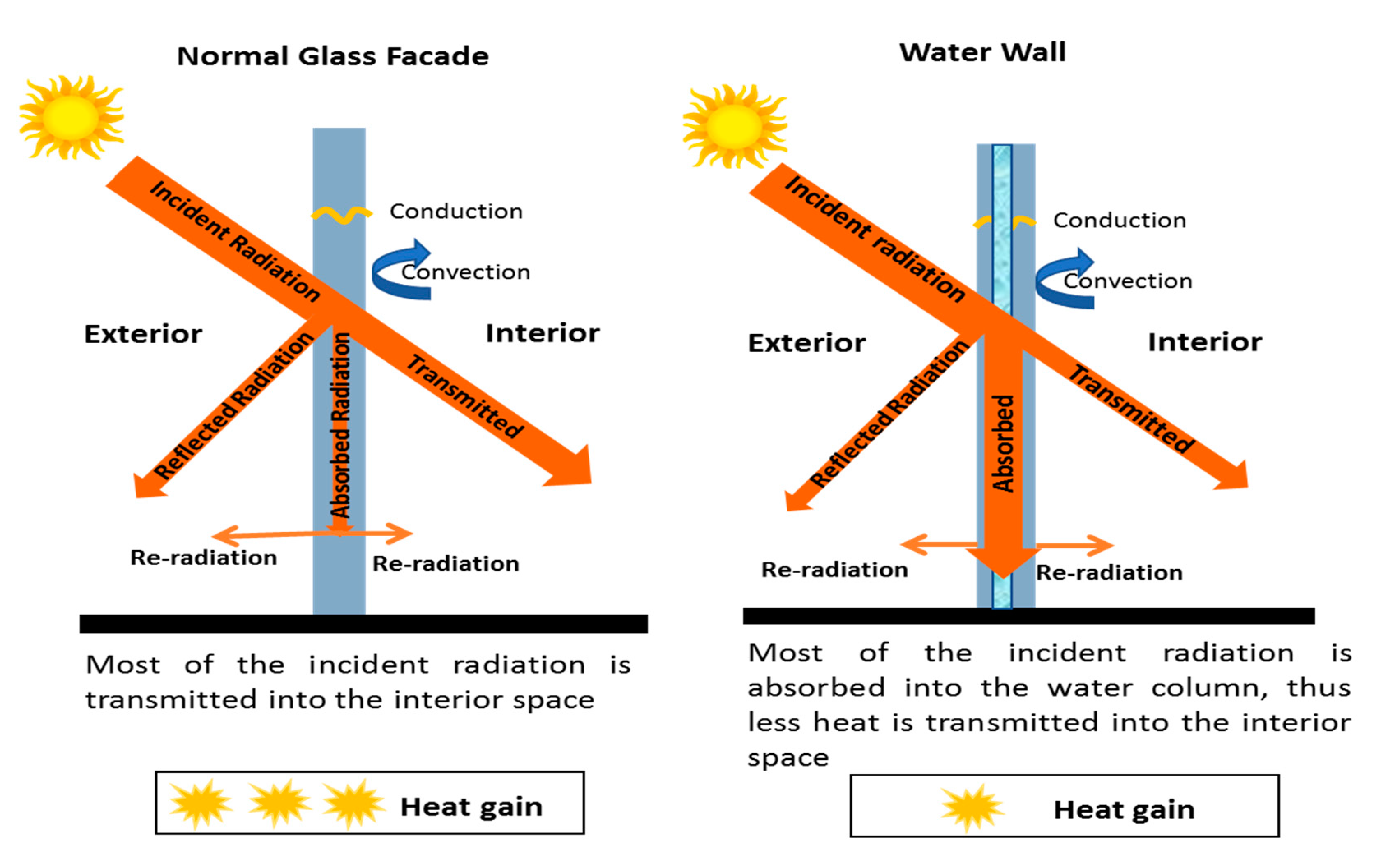

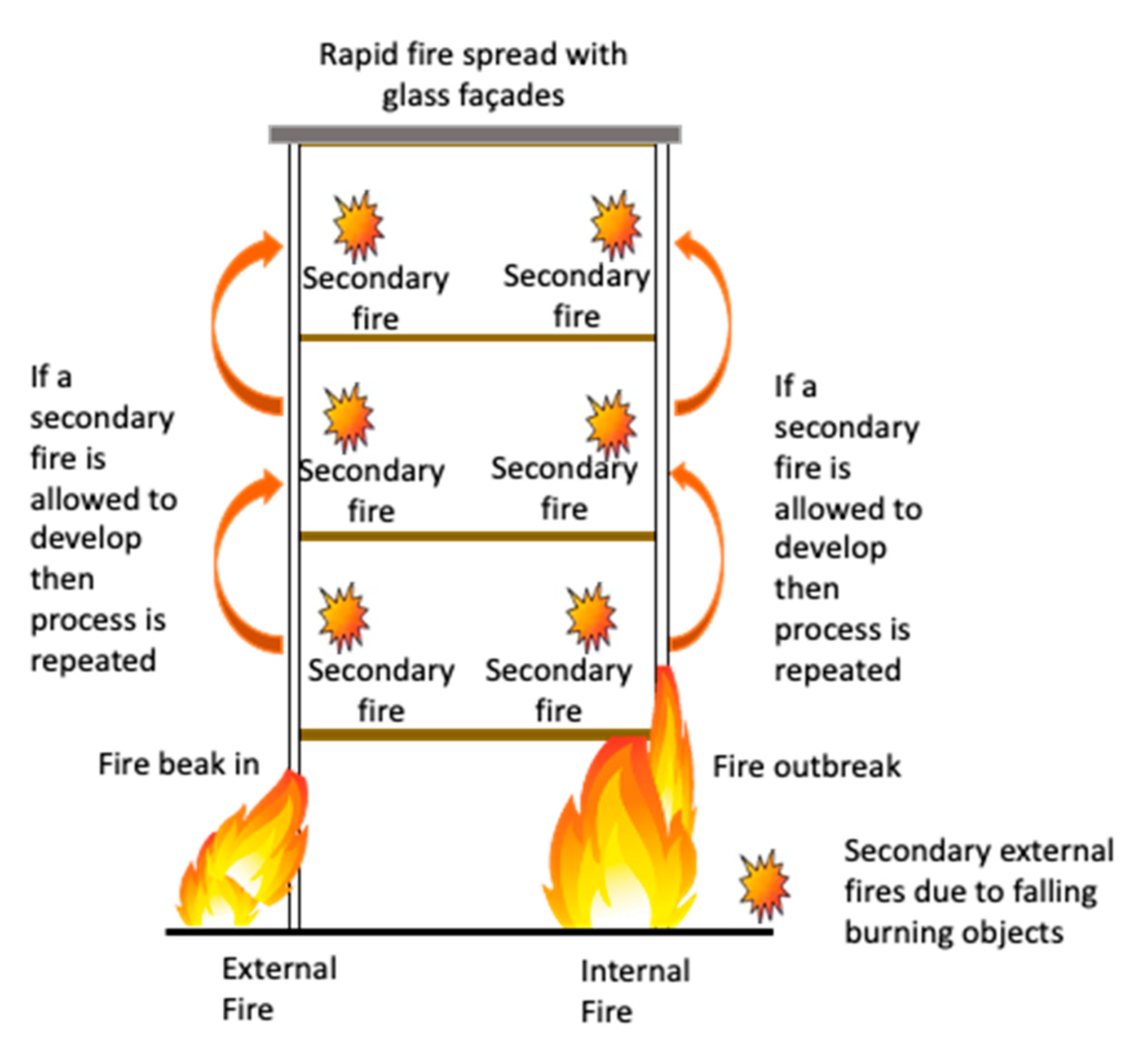
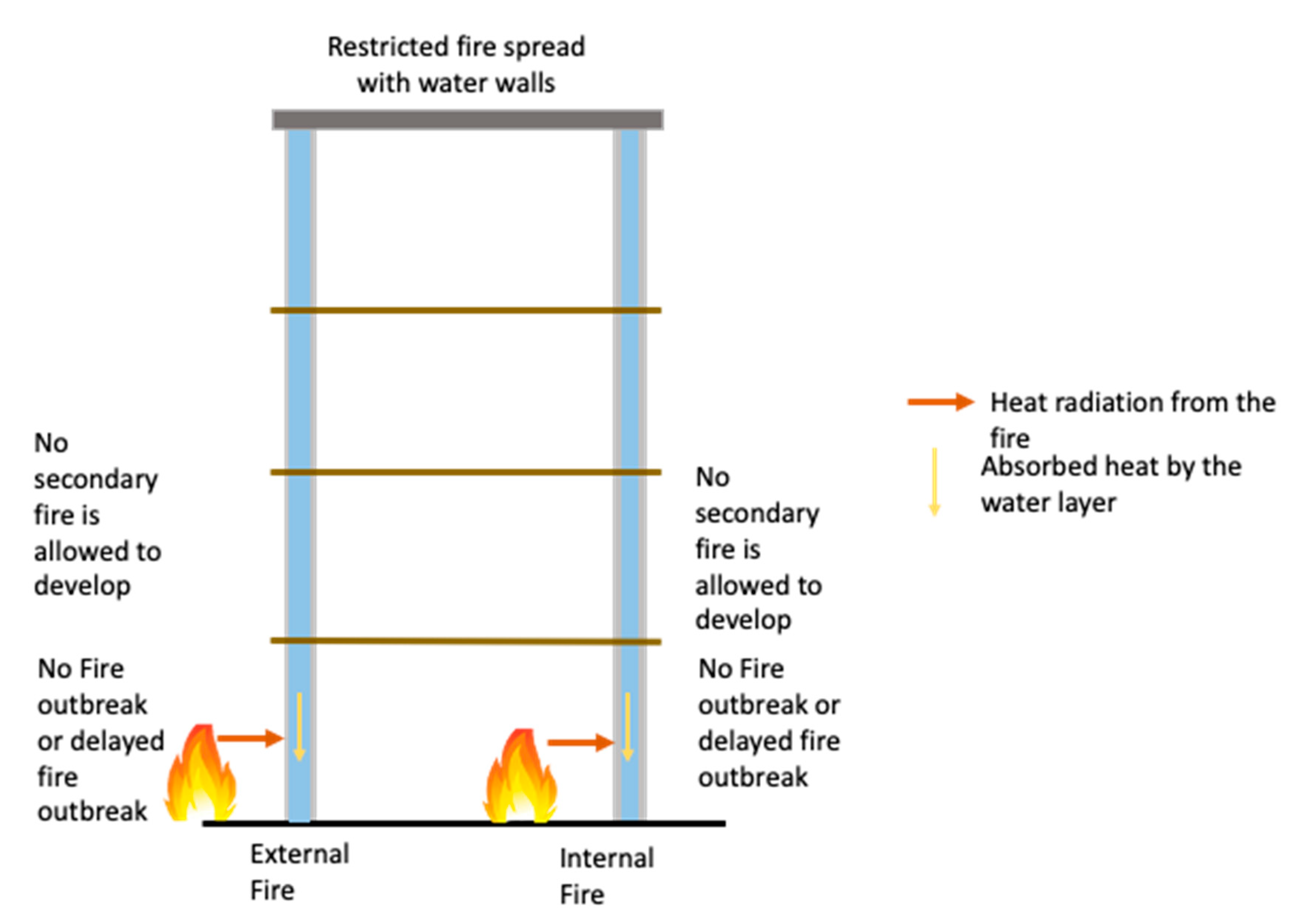
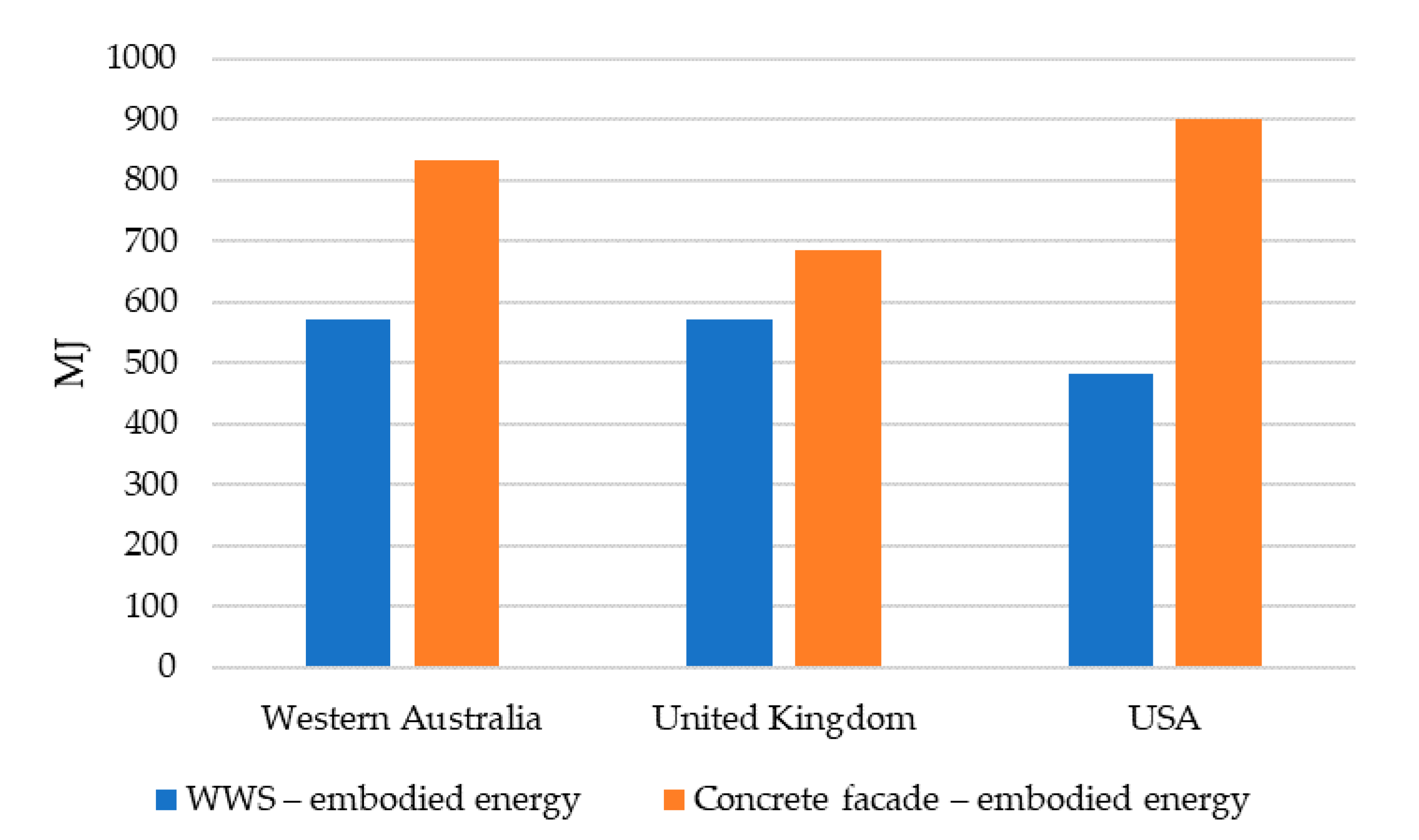

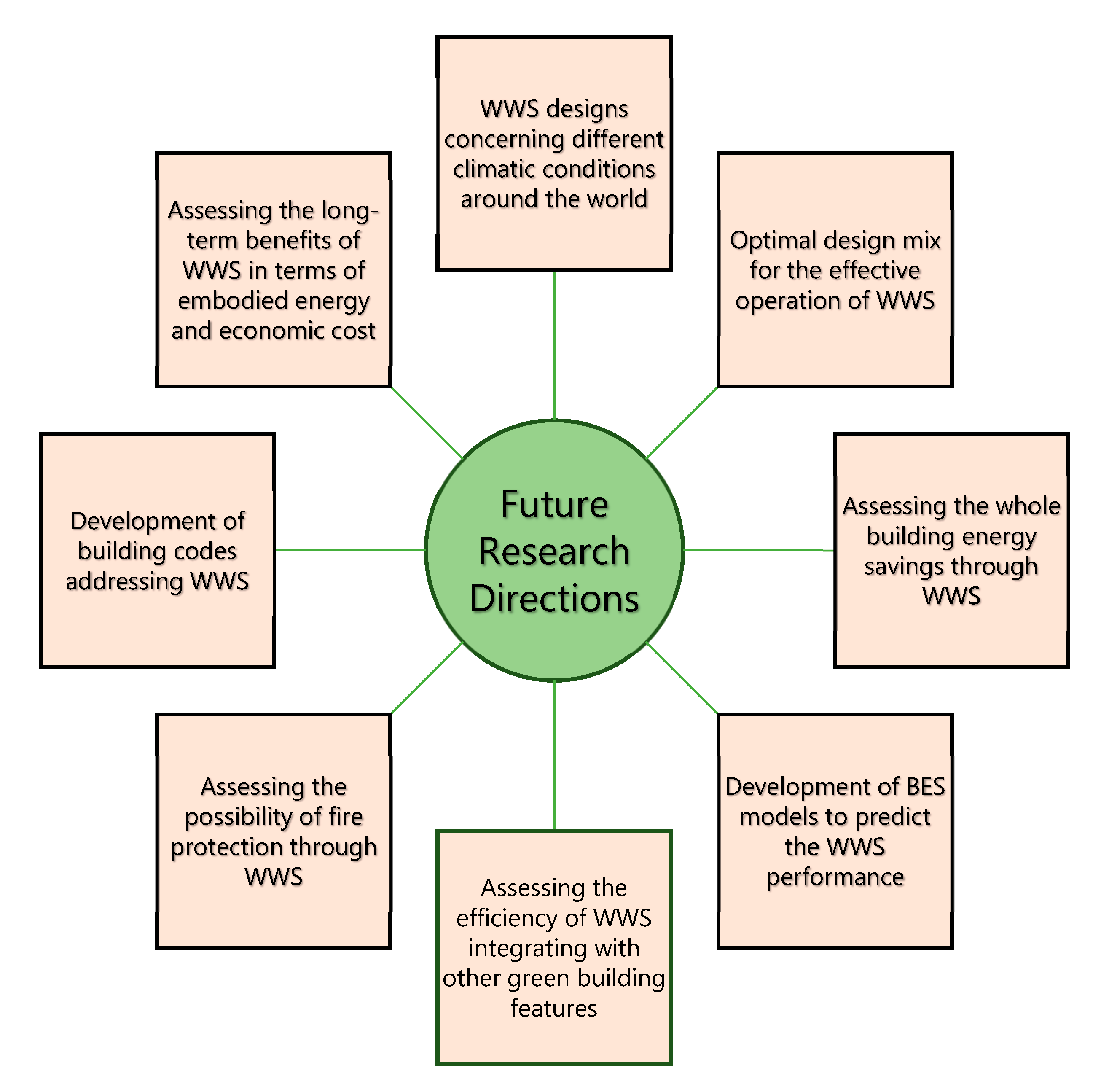
| Year | Location | Type of WWS | Method | Results |
|---|---|---|---|---|
| 1947 [35] | United States | WWS with opaque material | Experimental modeling | WWS has the capability to increase the thermal comfort level |
| 1978 [63] | United States | WWS with semi-transparent material | Experimental modeling | Water drums behind glass panes improve the thermal comfort inside the room |
| 1979 [70] | United States | WWS with semi-transparent material | Thermal Network Models | Solar heat gain in transwall is very close to the solar heat gain of Trombe wall |
| 1981 [82] | India | WWS with semi-transparent material | Transient Heat Balance Model (THBM) | The thermal performance of a semi-transparent water wall is more efficient than a concrete mass wall |
| 1986 [65] | Tasmania | WWS with opaque material | Experimental modeling | Energy consumption of a house with WWS is less (70%) than that of a concrete walled house |
| 1987 [34] | India | WWS with semi-transparent material | Experimental modeling | Semi-transparent WWS is more efficient compared to a concrete mass wall in terms of thermal performance in daytime |
| 1987 [83] | India | WWS with opaque material | Mathematical model | Large drums full of water kept inside a greenhouse can increase the thermal comfort |
| 1987 [71] | - | WWS with opaque material | Mathematical model | Complex heat transfer coefficients for WWS are developed |
| 1988 [67] | India | WWS with Phase Change Materials (PCM) | Experimental modeling | Water wall combined with PCMs as a link wall can increase the thermal performance |
| 1988 [75,84] | India | Collaborative-opaque water | Heat Balance Models (HBM) | The system reduces temperature fluctuations inside the room significantly |
| 1991 [72] | Leh | WWS with semi-transparent material | THBM | WWS performs better than the other considered thermal energy storage walls |
| 1991 [77] | India | WWS with semi-transparent material | THBM | WWS performs better than the other considered thermal energy storage walls |
| 1991 [76] | India | Collaborative-opaque water | THBM | For less temperature fluctuations with a maximum heat gain, the inner pane thickness of WWS should be at a minimum |
| 1992 [74] | Scotland and France | WWS with semi-transparent material | THBM | WWS can achieve energy saving of 23%—west of Scotland, 62%—south of France, compared to a concrete walled house |
| 1994 [66] | - | WWS with opaque material | Experimental modeling | WWS are efficient for summer days |
| 1994 [73] | India | WWS with semi-transparent material | THBM | WWS performs better than the other considered thermal energy storage walls |
| 1996 [69] | India | WWS with passive mechanisms | Experimental modeling | WWS reduces temperature fluctuations inside the room significantly |
| 2003 [68] | India | WWS with opaque material | Experimental modeling | A north-facing WWS with a thickness of 27.5 cm can increase the room temperature by up to 4–5 °C at night, and 3–4 °C in the daytime |
| 2007 [42] 2008 [85] | China | WWS with semi-transparent material | THBM | Natural convection effects are more influential than radiation effects, and the effect of natural convection in the water layer can be regulated if suitable geometric shapes are adopted |
| 2011 [81,86] 2018 [87] | Hong Kong | WWS with semi-transparent material | Experimental modeling, THBM | WWS can significantly reduce the indoor heat gain in both warm and cool climates |
| 2012 [78] | China | WWS with semi-transparent material | TRNSYS | WWS can decrease the room maximum temperature by 4 °C and increase the minimum temperature by 3 °C |
| 2013 [40] | Turkey | WWS with opaque material | Computational Fluid Dynamics (CFD) (FLUENT) | The thermal performance of wall heating systems is better than the floor heating systems in terms of thermal performance |
| 2013 [88] | Spain | WWS with semi-transparent material | Experimental modeling | The energy performance of WWS is more effective than the traditional windows |
| 2014 [79] | Spain | Collaborative (Sunspace) -Water wall in a sunspace | TRNSYS | A sunspace with WWS needs 12.9–16.7% less heating energy compared to a sunspace without WWS |
| 2015 [41] | Luxor, Egypt | WWS with opaque material | CFD | A pottery–water wall can reduce cooling and heating demand by 88% at extreme climatic conditions |
| 2015 [89] 2017 [90] | China | WWS with semi-transparent material | CFD | The effect of header design on the performance of WWS is insignificant |
| 2016 [37] | Sydney, Australia | WWS with semi-transparent material | CFD | Greater energy savings of WWS in winter climate compared to a concrete wall with same thickness, and in summer they perform in a similar way |
| 2018 [39] | Sidney, Australia | WWS with Passive mechanisms—with sunspace | Experimental modeling | The thermal comfort level is increased in the attached room by raising room temperature in winter as well as with a considerable ventilation |
| 2018 [43] | United States, Chicago | WWS with semi-transparent material | EnergyPlus + CFD | Thermal mass windows have a greater thermal performance compared to the traditional windows |
| 2018 [80] | - | WWS with semi-transparent material | TRNSYS + CFD | The proposed system is high in thermal performance and aesthetic appearance |
| 2019 [38] | Sidney, Australia | Collaborative (Solar Chimney)-Semi-transparent | THBM | A combined solar chimney and WWS can provide good ventilation and thermal comfort throughout the day and night |
| 2019 [91] | United States, Chicago | WWS with semi-transparent wall | Integrated Energy (IE) and CFD | Transparent water storage envelopes can result in 70% of heating and cooling load reduction compared to conventional glass facades |
| 2020 [92] | 13 cities | WWS with semi-transparent wall | Window Program + TRNSYS | WWS can result in energy saving of 3–84%/US$0.99–24.25/m2 based on the climate |
| Location | Glass Embodied Energy per Unit Mass (MJ/kg) | Concrete-Embodied Energy per Unit Mass (MJ/kg) | WWS Embodied Energy per 1 m2 of the Façade (MJ) | Concrete–Embodied Energy per 1 m2 of the Façade (MJ) |
|---|---|---|---|---|
| Western Australia [115] | 15 | 1.39 | 885 | 1737.5 |
| New Zealand [116] | 15 | 2 | 885 | 2500 |
| USA [117] | 12.7 | 1.5 | 749.3 | 1875 |
Publisher’s Note: MDPI stays neutral with regard to jurisdictional claims in published maps and institutional affiliations. |
© 2020 by the authors. Licensee MDPI, Basel, Switzerland. This article is an open access article distributed under the terms and conditions of the Creative Commons Attribution (CC BY) license (http://creativecommons.org/licenses/by/4.0/).
Share and Cite
Rathnayake, U.; Lau, D.; Chow, C.L. Review on Energy and Fire Performance of Water Wall Systems as a Green Building Façade. Sustainability 2020, 12, 8713. https://doi.org/10.3390/su12208713
Rathnayake U, Lau D, Chow CL. Review on Energy and Fire Performance of Water Wall Systems as a Green Building Façade. Sustainability. 2020; 12(20):8713. https://doi.org/10.3390/su12208713
Chicago/Turabian StyleRathnayake, Uthpala, Denvid Lau, and Cheuk Lun Chow. 2020. "Review on Energy and Fire Performance of Water Wall Systems as a Green Building Façade" Sustainability 12, no. 20: 8713. https://doi.org/10.3390/su12208713
APA StyleRathnayake, U., Lau, D., & Chow, C. L. (2020). Review on Energy and Fire Performance of Water Wall Systems as a Green Building Façade. Sustainability, 12(20), 8713. https://doi.org/10.3390/su12208713








